
Furniture refers to objects intended to support various human activities such as seating, eating (tables), storing items, working, and sleeping. Furniture is also used to hold objects at a convenient height for work, or to store things. Furniture can be a product of design and can be considered a form of decorative art. In addition to furniture's functional role, it can serve a symbolic or religious purpose. It can be made from a vast multitude of materials, including metal, plastic, and wood. Furniture can be made using a variety of woodworking joints which often reflects the local culture.

A chair is a type of seat, typically designed for one person and consisting of one or more legs, a flat or slightly angled seat and a back-rest. They may be made of wood, metal, or synthetic materials, and may be padded or upholstered in various colors and fabrics.

A couch, also known as a sofa, settee, chesterfield, or davenport, is a cushioned item of furniture for seating multiple people. It is commonly found in the form of a bench with upholstered armrests and is often fitted with springs and tailored cushion and pillows. Although a couch is used primarily for seating, it may be used for sleeping. In homes, couches are normally put in the family room, living room, den, or lounge. They are sometimes also found in non-residential settings such as hotels, lobbies of commercial offices, waiting rooms, and bars. Couches can also vary in size, color, and design.

Upholstery is the work of providing furniture, especially seats, with padding, springs, webbing, and fabric or leather covers. The word also refers to the materials used to upholster something.

A commode is any of many pieces of furniture. The Oxford English Dictionary has multiple meanings of "commode". The first relevant definition reads: "A piece of furniture with drawers and shelves; in the bedroom, a sort of elaborate chest of drawers ; in the drawing room, a large kind of chiffonier." The drawing room is itself a term for a formal reception room, and a chiffonier is, in this sense, a small sideboard dating from the early 19th century.
Chairs are known from Ancient Egypt and have been widespread in the Western world from the Greeks and Romans onwards. They were in common use in China from the twelfth century, and were used by the Aztecs. In Sub-Saharan Africa, chairs were not in use before introduction by Europeans.

A loveseat can be one of two styles of two-seat chair.
Upholstery coil springs are an important part of most modern upholstery. The consumer usually never sees the construction features of an upholstered piece. The overall quality of the materials and construction dictate the comfort level of an upholstered piece and its ability to satisfy the consumer over the long term. A basic upholstered piece may be composed of a frame, springs, foam, cushioning, padding, and textiles.
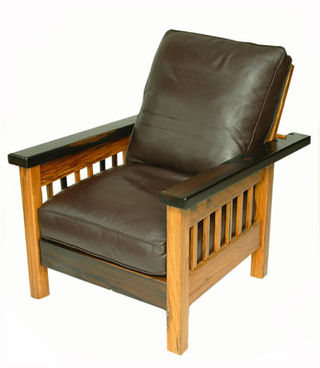
A Morris chair is an early type of reclining chair. The design was adapted by William Morris's firm, Morris & Company, from a prototype owned by Ephraim Colman in rural Sussex, England. It was first marketed around 1866.

The Louis XV style or Louis Quinze is a style of architecture and decorative arts which appeared during the reign of Louis XV. From 1710 until about 1730, a period known as the Régence, it was largely an extension of the Louis XIV style of his great-grandfather and predecessor, Louis XIV. From about 1730 until about 1750, it became more original, decorative and exuberant, in what was known as the Rocaille style, under the influence of the King's mistress, Madame de Pompadour. It marked the beginning of the European Rococo movement. From 1750 until the King's death in 1774, it became more sober, ordered, and began to show the influences of Neoclassicism.

A fauteuil is a style of open-armchair with a primarily exposed wooden frame originating in France during the early 17th century. A fauteuil is made of wood and frequently with carved relief ornament. It is typically upholstered on the seat, the seat back and on the arms (manchettes). Some fauteuils have a valenced front seat rail which is padding that extends slightly over the apron. The exposed wooden elements are often gilded or otherwise painted.
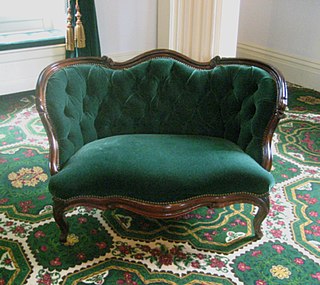
A canapé is a piece of furniture similar to a couch. The word is typically meant to describe an elegant couch made out of elaborately carved wood with wooden legs, an upholstered back, armrests, and single long seat that typically seats three, that emerged from France in the 18th century.
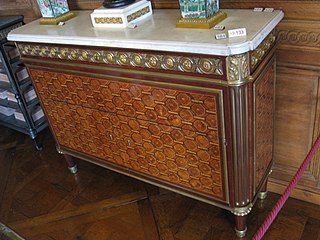
French furniture comprises both the most sophisticated furniture made in Paris for king and court, aristocrats and rich upper bourgeoisie, on the one hand, and French provincial furniture made in the provincial cities and towns many of which, like Lyon and Liège, retained cultural identities distinct from the metropolis. There was also a conservative artisanal rural tradition of French country furniture which remained unbroken until the advent of the railroads in the mid-nineteenth century.
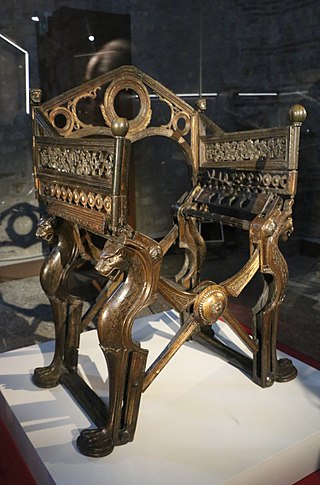
The Throne of Dagobert or Chair of Dagobert is a bronze chair made in the early Middle Ages and long associated with the Frankish and later French monarchy. After having been kept for centuries at the Abbey of Saint-Denis, it is now at the Cabinet des médailles of the Bibliothèque nationale de France in Paris.

Pierre Macret (1727–1806) was a well-known Parisian cabinetmaker (ébéniste). At the death of the widow of Jean-Pierre Latz in December 1756, he received Latz' court warrant as marchand-ébéniste privilégié du Roi suivant la Cour,, a brevet that exempted him from the stringent regulations of the Paris guild. In 1758 he was belatedly admitted maître-ébéniste by the guild, which henceforth required him to stamp his production. Numerous pieces bearing Macret's poinçon survive.

A cabriolet armchair is a Louis XV style chair with its armrests open and elevated from the seat, sculpted independently of the armchair, and making the chair light and easy to move—unlike the bergère, a similar style of chair that has enclosed, upholstered sides. The fauteuil en cabriolet with a concave back and overstuffed seat cushion is a version of this.
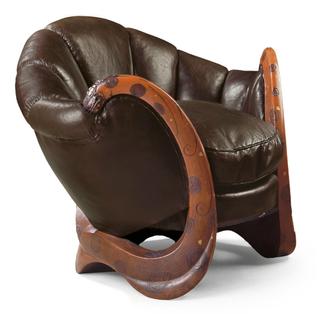
The "Dragons" armchair is a piece of furniture designed by the Irish architect and designer Eileen Gray between 1917 and 1919. "Dragons" armchair sold for €21,905,000 in 2009, establishing a new record for a piece of 20th century decorative art.

The furniture of the Louis XV period (1715–1774) is characterized by curved forms, lightness, comfort and asymmetry; it replaced the more formal, boxlike and massive furniture of the Louis XIV style. It employed marquetry, using inlays of exotic woods of different colors, as well as ivory and mother of pearl.

The furniture of Louis XIV was massive and lavishly covered with sculpture and ornament of gilded bronze in the earlier part of the personal rule of King Louis XIV of France (1660–1690). After about 1690, thanks in large part to the furniture designer André Charles Boulle, a more original and delicate style appeared, sometimes known as Boulle work. It was based on the use of marquetry, the inlay of pieces of ebony and other rare woods, a technique first used in Florence in the 15th century, which was refined and developed by Boulle and others working for the King. Furniture was inlaid with thin plaques of ebony, copper, mother of pearl, and exotic woods of different colors in elaborate designs.

















